|
The Italian Renaissance
During the 14th and 15th centuries, many Italian cities became important European centers of industry and trade. Living conditions
improved and people became more interested in their earthly existence than with life after death, a significant reversal of the attitudes
of their medieval predecessors. The term Renaissance, meaning "rebirth," derives from this renewed interest in life on earth and
a new confidence in humankind's potential for achievement. A revival of interest in the art and literature of the ancient Greeks and Romans,
which began in the 13th century, contributed to the
HUMANISM
of Renaissance Italy and greatly influenced its art. Renaissance art became increasing
NATURALISTIC
as artists studied the classical art of the past and their own world.
In order to reconcile the pagan classical past with Christian beliefs, Renaissance scholars looked for Christian morals in classical myths
whose original meanings were no longer understood. For example, Phaeton's unsuccessful efforts were equated with Lucifer's attempts to
get too close to god. Moralizers drew connections between Phaeton's demise and the Old Testament text of Isaiah 14:12 - "How art
thou fallen from heaven, O Lucifer, son of the morning." Interpreted this way, scenes of Phaeton falling from his chariot were very
popular in Renaissance art.
Cassone
This type of chest is usually referred to by its Italian name, cassone (cahss-OH-nay). Cassoni (cahss-OH-nee) plural of cassone were
most often used as marriage chests to hold brides' household linens, every item of which would have been woven by hand and embellished
with hand lace or embroidery or other "fancywork." Especially popular from the 14th to the 16th century, cassoni usually
featured scenes from the classical mythology so popular at this time. This cassone exemplifies the Italian Renaissance style of art,
particularly in its attention to the human body, the illusion of realistic spaces achieved through
PERSPECTIVE
techniques, and its adaptation of classical motifs.
This cassone tells the story of Phaeton in four carved panels. The first scene shows young Phaeton cavorting with the child who taunted him.
Typical of Renaissance figures, their bodies are turned and their knees are bent to convey a sense of movement. Their windblown drapery
enhances the sense of action. Their pseudo-Greek garb and tightly curled hair evoke ancient Greek sculpture. The artist achieved a
believable sense of depth by carving the frontmost figure in deeper
RELIEF.
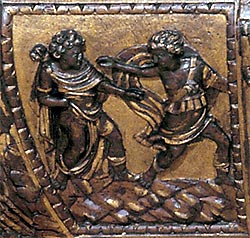
|
|
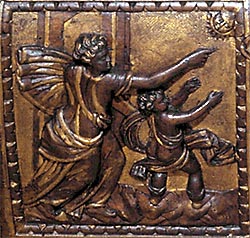
|
Panel 1 from the Cassone (Storage Chest) |
|
Panel 2 from the Cassone (Storage Chest) |
In the second panel, Phaeton's mother points in the direction of the sun, represented as a stern human face with rays. Phaeton eagerly reaches
out toward his father. His partially nude body is babylike, reminiscent of Greek carvings of Cupid. Again, action is achieved with
billowing drapery. The artist creates the illusion of space by carving the doorway behind the figures in low relief and by making the
distant sun very small.
The third scene shows Phaeton on his knees before his mighty father, who is here represented as a man standing on a decorated platform. The
marvelous palace of Helios recalls classical architecture.
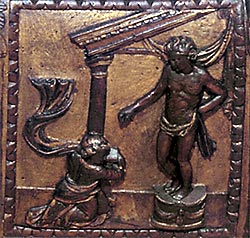
|
|
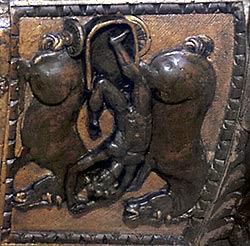
|
Panel 3 from the Cassone (Storage Chest) |
|
Panel 4 from the Cassone (Storage Chest) |
The cassone's final panel shows the image of Phaeton most familiar during the Renaissance. Phaeton, now represented as a nude adult, tumbles
from the chariot alongside two falling horses. The anatomy of Phaeton and the horses is remarkably well rendered.
Many adaptations of classical motifs decorate this elaborate cassone. On the corners are harpies - monsters with the heads and breasts of women
and the wings and claws of birds - which were said to torment misers. Harpies symbolized the deadly sin of greed (avarice) in many
Renaissance moral allegories. The five heads punctuating the horizontal band above the main scenes and the single large face at the
center bottom of the chest are variations on satyr and gorgon masks. The empty central oval, held up on either side by putti (winged
infants), was intended to enclose the coat-of-arms of one of the bride's and groom's families, or possibly of both families combined.
One face conceals the key hole in its mouth. Around these faces are anthemia, conventional floral motifs based on the honeysuckle or
palmette. The leaves in the narrow band around the lid of the cassone are acanthus, another popular classical decoration.
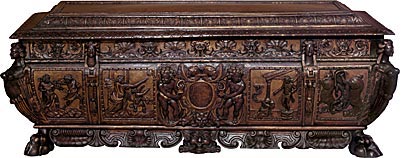
|
Roll over the image to locate the harpies, satyr, gorgon, putti, anthemia, & acanthus from the Cassone (Storage Chest) |
Although this cassone was made for a bridal couple, both its shape and its more gruesome motifs (such as the harpies) ultimately derive from
ancient Roman stone coffins called sarcophagi (sar-COH-fa-gee). During the late Renaissance period in Italy, there was a widespread
taste for excessively ornate furniture with densely packed ornamentation. Wood carvers, particularly in Rome, were heavily influenced
by the decoration on surviving antique sarcophagi, as well as by contemporary trends in sculpture and architecture.
|











